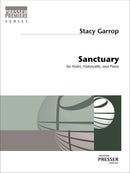| 作曲者 | Stacy Garrop (b. 1969) |
| タイトル | Sanctuary (Score & Parts) |
| 出版社 | Theodore Presser・プレッサー |
| 楽器編成 | ピアノ三重奏曲,Piano Trio |
| 楽器編成(詳細) | Violin, Violoncello, Piano |
| 品番 | HLTHE11441825 |
| 形状 | 76 ページ・22.9 x 30.5 cm |
| 演奏時間 | 23:00 |
| 出版年 | 2017年 |
| 出版番号 | 114-41825 |
In 2011, Barbara Garrop, my mother, commissioned me to write a piano trio in memory of Norman Garrop, my father, who passed away about thirty years ago. When I started brainstorming about topics for the piece, I found it difficult to recall many moments of my early life involving my father. Too many years had passed, and the memories that I could summon were of achild looking up to her father, not an adult relating to an equal. However, while collecting stories of my father from various family members, along with discovering a number of objects that had once belonged to him and that I had stored away in boxes decades ago, I began to realize that this piece wasn't so much about my father as it was about my re-discovering the man that he was: a loving husband and dad who cared deeply about his family and his passions (which included bike riding, collecting coins, strumming our guitar, playing baseball, watching football games, entertaining people, helping to run local theater and puppet productions, and carving objects out of wook); an accountant who dreamed of a better future: a treasurer of our local synagogue; an early advocate for computers (we owned an Apple II+); and a pranster with a great sense of humor. Ultimately, I decided to musically tell the story of my search for these memories. In the first movement ("Without"), a child calls out in a sing-song voice, searching for her lost parent. This search intesifies over the course of the movement through a series of themes, including a "stepping" motif in which a two-note progression steadily climbs higher, a pseudo-jewish folksong, and a passionate "longing" theme. The child's search becomes increasingly intense throughout the movement, calling out fervently and repeatedly to the parent; the movement ends in a moment of great tnesion and uncertainty. The second movment ("Within") quietly opens with the lost parent finally answering, represented by a solo cello; the child (now personified by the violin) has found the parent within the sanctuary of her own heart. This movement highlights the joy and solemnity of this beautiful discovery. -S.G.
I. Without
II. Within



